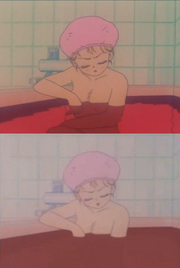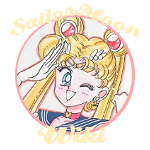Sailor Moon's logo in North America
Sailor Moon in North America covers every notable English version of the metaseries, including fan-subtitled versions.
Anime
English dub
The English dub of Sailor Moon is probably one of the most notable dubs for two reasons. The first is that its wild popularity introduced anime to many viewers in North America who had never before heard of such a thing. The second is the infamous and overwhelming amount of changes, censorship and cuts which have caused many English-speaking fans to turn to subtitled versions of the original Japanese rather than the dub. This dub was also broadcast on the British channel Fox Kids which could be picked up in Ireland on analogue.
History
In 1995, DiC won the rights to Sailor Moon in North America. The series was a sixty-five episode package, with seven episodes cut for reasons unknown. The series did so poorly in syndication that after the run had completed, DiC dropped the show and made no effort to bring the series to even the end of the second season.
After two years, DiC was convinced to purchase and dub another hundred and twenty episodes. This was cut down to seventeen, which would bring the series to the end of R, the second season. The series had become phenomenal in popularity after being aired on Cartoon Network's Toonami block and had been popular from the start in Canada, so there was high demand for more episodes.
Finally in 2000, Cloverway, Toei's United States branch, bought the rights and dubbed Sailor Moon S and Sailor Moon SuperS.
The second two series were highly rushed, because Cloverway was being pushed by Cartoon Network to finish dubbing within several months. In 2001, soon after the last two series ended, Pioneer released them on DVD, including a subtitled version. In 2003, the first two seasons were released in the same way by ADV.
Toei has stated that the last season, Sailor Moon Sailor Stars, will never be sold to any American company, because Toei refused to sell the rights to dub it. Despite the fact that SuperS ends on a cliffhanger point due to the series' abysmal fan reception, even the first part of Sailor Stars (which is the end of the SuperS arc) will never be officially released in North America.
Censorships, Cuts and Changes
This is a table of main character names in the English dub. Although Hotaru's name is the same, it is pronounced differently.
Especially in DiC's version, there were many changes (unsurprising given that the first 15 episodes were directed by Carl Macek). Most of the main characters' names were changed (except for Hotaru Tomoe) and major plot elements were abolished or corrupted.
In the first season, some of the content from the final episodes was added onto the first episode as an introduction. This spoiled the plot of the show. A character's gender was changed and much valley girl slang was sprinkled everywhere. The term "soldier" (or guardian) was changed to "scout," presumably to avoid connotations of war.
Five episodes were cut from the series and footage was also cut from the episodes themselves. The final two episodes had enough footage removed that they were merged into one episode. The deaths of the soldiers were explained as them having been "kidnapped" by the Dark Kingdom (Negaverse), something which confused even fans who had never seen the original.
The second season received much the same treatment, with one episode cut, bringing the number of episodes lost to seven.

A bathing scene in the original series and the English dub. In the English dub (second image), the water is made opaque.
Changes made in both the first two seasons include the elimination of any hint of violence, the erasing of breast lines in the transformation sequences, playing certain scenes twice (once forwards and once reversed) to avoid objectionable parts without losing time. There was also a "Sailor Says" segment after every episode, extolling a moral virtue of the episode, along with the opening text from the first two weeks (see above).
Once Cloverway started dubbing the series, there were many improvements but also many downfalls. Because of the rush to complete the show in time for its summer run, there was not enough time to rescore the show, or make as many changes. The more faithful scripts may also have been influenced by demand from the fans. The introduction of a TV ratings system for children also helped to lessen censorship, as the show was rated Y7-FV due to the amount of violence. However, Cloverway's episodes had many mistakes and inconsistencies, also because of the speedy production. For example, most attack names in this dub didn't retain their original DiC names.
Some of these mistakes include characters forgetting their names from past seasons and attack and transformation names changing from episode to episode. In addition to these inconsistencies, Cloverway made some major changes of their own, including the decision to change three characters' genders (Zirconia and Falion for no apparent reason) and the "hiding" of Haruka Ten'ou and Michiru Kaiou's lesbian relationship by calling them cousins.
Official subtitled version
The official subtitled version in the ADV and Pioneer releases is uncut and uses the original names, though fans have complained of minor dialogue changes.
The subtitled version is considered to be much belated by many fans, as the first two seasons were released eight years after they had aired. By the time the official release had come out, many fans had already bought fan subtitled versions and were not willing to spend the money.
Template:Sect-stub
Fansubs
The most notable maker of Sailor Moon fansubs is VKLL. Although the early tapes had silly mistakes (such as Sailor Uranus' Space Sword Blaster being translated as "Crystal Attack"), they were extremely popular because they filled a void in the market. It helped that the tapes were extremely cheap due to the illegality of making a profit from fansubs; buyers paid only for the cost of the tape and shipping.
Template:Sect-stub
Quebec
Quebec used the same opening as France. A big jammer was put up to keep the English dub's signal out. [1] Only 9 episodes were dubbed into Quebec French.
Manga
Tokyopop and Mixx
Mixx is the only North American company that has held on to the series long enough to translate and release the entire thing. It was published in three story arcs: "Sailor Moon," running from the beginning of the series to the end of the Infinity arc (S), Sailor Moon SuperS (Dream Arc) and Sailor Moon StarS, the Sailorstars arc.
History
Sailor Moon was originally published in Mixxzine and was the magazine's launching point. Starting in August 1997, it was serialized bimonthly. In the February 1998 issue, it was announced that it would be compiled into a Pocket Mixx edition as well, each book of which would correspond to the original graphic novels.
At the same time, Mixx revealed the launch of their new magazine, Smile. The original premise was for the magazine to be a generic girls' fashion periodical, featuring reader-sent photos of ordinary girls and their families.
But by the time the magazine was discussed further, Sailor Moon had been slated to move to Smile. After much controversy and tension concerning Mixx Magazine's new format and a web page hacking, Smile was launched in October 1998, its main selling point being Sailor Moon. Fans who wanted to continue reading Sailor Moon and the other manga in Mixx Magazine had to get subscriptions to both periodicals, unfortunate for those who were not teenage girls and were not interested in Smile.
After some time, Smile's format became that of a girls' anime anthology magazine, effectively eliminating the magazine's original purpose. This pleased most fans, but some felt that the effort was "too little, too late."
Changes and errors
Sailor Moon was Mixx's first translation, and while little was deliberately changed, per se, many things were Americanized and lost in translation. Examples include the retention of the DiC names for all characters except Usagi Tsukino (called Bunny in Mixx) until S, where Sailors Uranus, Neptune and Saturn retained their original names. However, they were sometimes called Alex/ Erica, Michelle and Jenny (respectively), presumably by mistake. Another famous error is the retranslation of a Yeats poem into English.
Several minor characters had their names grossly mistranslated, such as Ptilol as "Petite Roll." Chibi Chibi's name was supposed to be based on her constant repetition of the word "Chibi," which she said because she had heard Usagi's mother say Chibiusa's name, but in the Mixx manga, Chibiusa's name was Rini. In Chibichibi's first scene, the name is mentioned as ChibiUsa.
The names Sailor Lead Crow and Sailor Chuu were translated as "Sailor Red Crow" and "Sailor Chew", respectively. Sailor Ceres and Sailor Pallas were called "Sailor Celis" and "Sailor Palis," obliterating the asteroid reference. The Galaxy Cauldron was also translated as "Galaxy Cordon."
Sailor Venus' nickname V-chan was amusingly mistranslated as V-babe (they were thinking of tan, chan means little but tan is a nickname given to someone you have a crush on)
Controversy
Despite their intention of keeping the series as close to the original as possible, Mixx has been surrounded in controversy since the beginning.
In July 1998, the editor-in-chief of Mixx Magazine, Ron Scovil, ended his tenure and left Mixx. Soon after, he started a webpage called Eye On Mixx, intended to show Mixx's "true intentions." He had many friends and allies from the Mixx Online Messageboard, which was shut down after the launch of Smile due to fan misbehaviour. Fans complained about Smile magazine, and made allegations that Mixx had created false accounts on their boards to support their cause and deleted negative opinions.
When, in November, the latest issue of Mixx magazine was released, it was much thinner but cost the same. The magazine was filled with articles on music and CDs, as well as the usual anime articles, whereas the manga itself had been flipped sideways and sized down to fit two to a page.
Less than hours after the magazine came out, Mixx's website was hacked. The main page was replaced with an X-rated graphic of Sailor Moon, with a notice below it telling fans that Stu Levy (president of Mixx) was a "money-grubbing liar."
Three days later, after the page had been replaced, Stu Levy posted a seven-page "response" to the controversy that flew around Mixx and Ron Scovil.
The Eye on Mixx messageboard became the new base for Mixx fans after the official board was shut down. The fans were tired of the way they were being treated and rallied around Eye on Mixx to keep then informed.
Alex Glover's translation
Located at The Manga of Takeuchi Naoko, Alex Glover's translation was used by many fans who dislike the Mixx translation. Acts 1-16 are based on the newer prints of the manga and read like a script, whereas acts 16-52 were translated from the old version and are written like a story. This is because acts 1-16 were translated from the newer Pretty Guardian Sailor Moon release, but this translation was never finished so Glover posted the old translations instaed.
Alex Glover's translation is used by many fans to prove that Chibichibi is not any form of Sailor Moon.
Live-action & Seramyu
Because there have been no plans to release these series domestically, both have been largely supplied to the North American audience by fansubbers, by means of Bittorent. One fansubber, 380 fansubs, occasionally throws in dirty jokes and puns, often confusing new viewers to the series. They term this "partial parody subbing."
Futher Reading
- Cloverway
